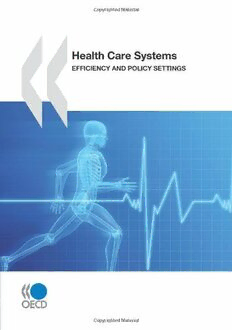
Health Care Systems: Efficiency and Policy Settings PDF
211 Pages·2010·5.415 MB·English
Most books are stored in the elastic cloud where traffic is expensive. For this reason, we have a limit on daily download.
Preview Health Care Systems: Efficiency and Policy Settings
Description:
People in OECD countries are healthier than ever before, as shown by longer life expectancy and lower mortality for diseases such as cancer. At the same time, total spending on health care now absorbs over 9% of GDP on average in the OECD. Achieving value for money in the health care sector is an important objective in all OECD countries. The book takes an in-depth look at health care in OECD countries today. What is the status of peoples health? How do we measure health outcomes? How do we assess the efficiency of health care systems? How are health policies and institutions linked with the performance of health care systems? The chapters explore the answers to such questions. They cover: trends in health care outcomes and spending; ways of assessing efficiency; new indicators of health care policies and institutions; and the characteristics and performance of health care systems. Table of Content :AcronymsExecutive summaryChapter 1. Health care outcomes and spending-Introduction-A significant improvement in health care outcomes over the last decades-Spending on health care: pressures have been strong and are projected to intensify-Annex 1.A1. Definitions and sources Chapter 2. Efficiency measures-Introduction-Defining efficiency: the concept and three approaches-Health status determinants: accounting for lifestyle and socio-economic factors-Defining an efficiency frontier and measuring the distance to this frontier-Complementing aggregate efficiency indicators-Annex 2.A1. Additional information on health care outcomes, spending and efficiency -Annex 2.A2. Selected empirical work linking health outcomes and inputs-Annex 2.A3. Specification and empirical results of panel regressionsChapter 3. Health care policies and institutions a new set of indicators-Introduction-Policy settings as seen through the prism of indicators-Steering demand and supply of care: indicators on market mechanisms and regulations-Promoting equity in health care access: indicators on health care coverage-Controlling public spending: indicators on budget and management approaches-Annex 3.A1. Market failures and imperfections in health care systems-Annex 3.A2. Coding indicators on health policy and institutions examples-Annex 3.A3. Principal component and cluster analyses-Annex 3.A4. Principal component analysis on budget and management approachesChapter 4. Linking efficiency and policy across health care systems-Introduction-Identifying health care systems-Linking health system performance and policy indicators-Drawing comparisons and identifying strengths and weaknesses -Policy lessons from the international benchmarking exercise -Annex 4.A1. Individual country profilesBibliography
See more
The list of books you might like
Most books are stored in the elastic cloud where traffic is expensive. For this reason, we have a limit on daily download.
